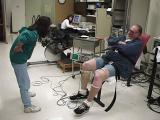Investigators: David A. Brown, PhD, PT and Charles G. Burgar, MD Project Staff: Cheryl D. Pierson-Carey, MS, PT; Steven A. Kautz, PhD; M. Elise Johanson, MS, PT; Christine A.Dairaghi, BS; Betty S. Troy, MS; Douglas F. Schwandt, MS; and James H. Anderson, JEM Project Category: Stroke - 2000 The purpose of this study was to test the efficacy of a new exercise regime for improving lower extremity function in persons with post-stroke hemiplegia. The exercise is performed by pedaling an ergometer, but instead of sitting, the patient stands safely on the pedals and is partially supported by a tiltable backboard, with the amount of weight-bearing graded according to the patient's level of recovery. The angle of the backboard determines the portion of body weight that must be supported by the legs. The exercise is intended to strengthen the weaker limb and improve weight-bearing capability. For these reasons, we expected to see better carryover to general lower limb function than is seen with conventional single joint or single limb training methods. Since the movements are simple and constrained, the exercise is appropriate for patients at all levels of motor recovery. Furthermore, the tiltable backboard provides greater trunk stability than other partial weight-bearing techniques, such as suspension in a harness, making the exercise suitable for non-ambulatory patients and allowing training to begin early post-injury. Study objectives: to demonstrate improved lower limb strength, weight-bearing capability, and functional ambulation in a group of chronic hemiplegic subjects training with graded weight-bearing (GWB) pedaling when compared with conventional therapeutic exercise techniques. Subjects had chronic hemiplegia (>6 months since stroke) and underwent initial (4 and 1 week prior to intervention), interim (6 weeks after initiation of intervention), and final measurements (1 and 4 weeks post-intervention) of lower limb strength, weight-bearing capability, and functional ambulation. Subjects were randomly assigned to one of two groups. The conventional therapy (CT) group underwent a 3X/week for 12 weeks conventional protocol of therapeutic exercises aimed at improving lower limb strength and weight-bearing capability. The GWB pedaling group participated in a 3X/week for 12 weeks regimen of non-seated pedaling. In addition, both groups underwent functional gait training therapy in the remaining two days of each week. Statistical analyses were used to determine whether significant differences were present in the changes in the strength, weight-bearing capability, and functional ambulation tests performed either with CT or GWB intervention. Findings to Date: Twenty-six subjects completed the protocol, 13 in each group. Results showed a significant increase in strength, weight-bearing capability, and functional ambulation after both the CT and GWB training regimens. In addition, 4 weeks of gait training enhanced the improvement in functional ambulation that was gained with training. There was no statistically significant difference between gains with GWB versus CT. Therefore, we can conclude that strengthening exercises are not harmful to functional ability, as has been previously hypothesized. An important clinical implication of this study is that one single, easily administered exercise regimen, the graded weight-bearing technique, can provide equivalent outcomes and an efficient substitute for a more complex regimen of lower limb weight training. Presentation: Burgar C. Robotics and assisted movement: Assessing, correcting, and compensating for motor impairment. VA/PVA National MS Conference, Chandler, AZ: Feb. 4-5, 1999. Funding Source: VA RR&D Merit Review |
